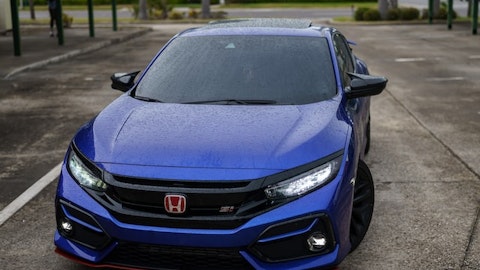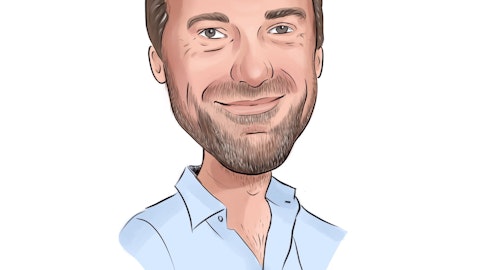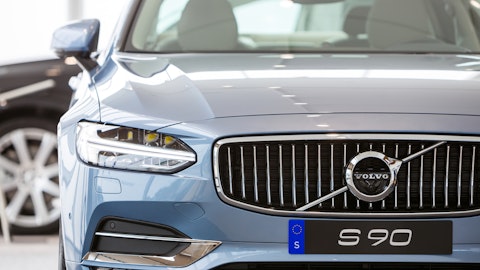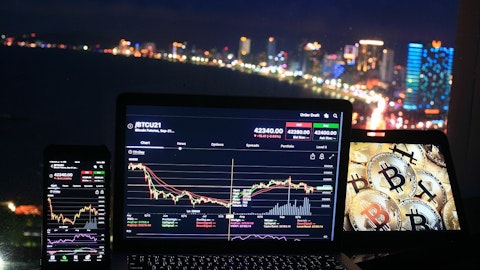LKQ Corporation (NASDAQ:LKQ) Q3 2023 Earnings Call Transcript October 26, 2023
LKQ Corporation misses on earnings expectations. Reported EPS is $0.86 EPS, expectations were $0.95.
Operator: Thank you for joining the LKQ Corporation Third Quarter 2023 Earnings Call. [Operator Instructions] I’d like to go ahead and introduce our speaker today, Joe Boutross, with LKQ Corporation. Please go ahead.
Joe Boutross: Thank you, operator. Good morning, everyone, and welcome to LKQ’s third quarter 2023 earnings conference call. With us today are Nick Zarcone, LKQ’s President and Chief Executive Officer; and Rick Galloway, Senior Vice President and Chief Financial Officer. Please refer to the LKQ website at lkqcorp.com for our earnings release issued this morning as well as the accompanying slide presentation for this call. Now, let me quickly cover the Safe Harbor. Some of the statements that we make today may be considered forward-looking. These include statements regarding our expectations, beliefs, hopes, intentions or strategies. Actual events or results may differ materially from those expressed or implied in the forward-looking statements as a result of various factors.
We assume no obligation to update any forward-looking statements. For more information, please refer to the risk factors discussed in our Form 10-K and subsequent reports filed with the SEC. During this call, we will present both GAAP and non-GAAP financial measures. A reconciliation of GAAP to non-GAAP measures is included in today’s earnings press release and slide presentation. Hopefully, everyone has had a chance to look at our 8-K, which we filed with the SEC earlier today. And as normal, we are planning to file our 10-Q in the coming days. And with that, I’m happy to turn the call over to our CEO, Nick Zarcone.
Nick Zarcone: Thank you, Joe. Good morning to everyone on the call, and thank you for joining us. This morning, I will provide some high-level comments related to our performance in the quarter, and then Rick will dive into the financial details and provide an overview of our updated guidance, before I come back with a few closing remarks. The third quarter of 2023 represented some mixed results, which collectively fell short of our expectations. Wholesale North America continued to outperform, all while working on the integration of the Uni-Select acquisition. However, we experienced some unusual transitory events that, in aggregate, affected the short-term performance of our European operations. We also had continued pressure on commodities, which impacted Self Service, along with less-than-expected demand for our specialty products.
The LKQ culture is one that takes accountability for results and is humble enough to understand that this quarter’s results fell short of both our expectations and the expectations that may view on the call. Make no mistake, the shift to our operational excellence strategy implemented in 2019 has not changed. Structurally, our business model and financial outlook are sound, and we continue to be very optimistic about the future of LKQ. One quarter does not define the resiliency of our business model, the uniqueness of our global enterprise or the long-term opportunities that lie ahead for LKQ. The perpetual challenging macroeconomic conditions are not unique to LKQ, and they will continue to persist, but the LKQ team will move forward. On the positive side, we continue to experience strong organic revenue growth in our North American and European businesses achieving same-day growth of 5.8% and 6.2%, respectively.
North America achieved excellent EBITDA margins, which were ahead of expectations, and our free cash flow was excellent, particularly in North America and Europe. On the downside, during the quarter, we faced a few unusual and transitory headwinds. In late September, our Italian subsidiary, Rhiag, completed a negotiation with the Italian tax authorities on the remediation of a value-added tax violation that was committed by certain of our third-party suppliers dating back to 2017. These suppliers are no longer in business, and thus, Rhiag agreed to remit the disputed amounts to the Italian revenue agency to remedy any damage caused by the VAT violations of the former suppliers. Additionally, our German operation was hit with periodic strikes at our large distribution center, which reduced our ability to fully replenish the branch network with inventory on a daily basis.
Negotiations with the works council are ongoing, but there have been additional strikes in October, which will affect our Q4 results. It’s important to note that resolving the matter is not fully in our control as the labor contract involved with some multiple employers in Southern Germany that must agree on terms through the employers association. These two items alone reduced our European organic growth by approximately 160 basis points and reduced segment EBITDA margins by 110 basis points. While we are disappointed with these two transitory items, our long-term view of the growth and margin potential of our European business has not changed. Related to commodities, pricing pressure continued in the third quarter, with scrap and precious metal down sequentially 14% and 23%, respectively, decreasing both margins and earnings per share.
For context, in Q3, catalytic converter prices fell below $100 for the first time since early 2019, versus the third quarter of last year, when they averaged to $197. This difficult commodity environment, again, had a particularly negative impact on the profitability of our Self Service segment. Rick will provide a deeper dive into the EPS and segment margin details in the quarter when he discusses our updated guidance. The quarter included many other highlights worth noting. The company generated robust free cash flow, and we are on target to again reach $1 billion for 2023. On August 1, we announced the completion of the Uni-Select acquisition, a bespoke and highly synergistic opportunity that will add positive long-term shareholder value and further widen the competitive moat around our North American business.
Yesterday, we completed the sale of GSF Car Parts to Epiris, a private equity firm based in the UK, the proceeds from the sale will be used for debt repayments. And finally, our Board has declared a 9% increase in our quarterly cash dividend from $0.275 to $0.30 per share of common stock. This increase reflects the Board’s ongoing confidence in our ability to continue to generate solid free cash flow and drive long-term value for our shareholders. Now, on to the third quarter 2023 results and year-over-year comparisons. Revenue for the third quarter of 2023 was $3.6 billion, an increase of 15%. Parts and services organic revenue increased 3% on a reported basis and 4.3% on a per day basis. Diluted earnings per share was $0.77 as compared to $0.95 for the same period last year, a decrease of 18.9%.
While adjusted diluted earnings per share was $0.86 compared to $0.97 for the same period of 2022, a decrease of 11.3%. Let’s turn to some of the quarterly segment highlights. As you will note from Slide 8, organic revenue for parts and services for North America increased 4.1% on a reported basis and 5.8% on a per day basis. We continue to perform well in North America, especially when you consider that non-comprehensive related auto claims were down 4.3% year-over-year in the third quarter. Similar to the first half of the year, the growth in North America was a combination of price and volume improvements, with the organic growth in our aftermarket collision products predominantly being volume-related. These nice volume increases were driven by our disciplined procurement efforts that allowed us to achieve the proper levels of inventory and the ability to stabilize and maintain our industry-leading fulfillment rates of over 93%, which helped us grow the business.
The strong volume was also attributable to State Farm, expanding their usage of aftermarket headlights, taillights and bumpers beginning earlier this year. Further on State Farm, during our last call, I mentioned that State Farm launched another pilot program in California and Arizona for the use of a full range of aftermarket collision parts, including sheet metal products like fenders, hoods and trunk lids and other items like side mirrors and grills. Today, I am pleased to share that on October 16, State Farm announced that they are rolling out the use of these parts nationally to collision repair shops, which are part of their DRP program. We expect the incremental lift from this expansion at a full run rate will reflect a $20 million to $30 million annual benefit in revenues once fully ramped up.
With respect to the UAW strikes, we believe that a continuation of the strikes will create incremental demand for our aftermarket and to a lesser extent, our recycled collision parts. Because the strike started in late September, there was no impact on our third quarter results, but we are starting to see an incremental per day volume uptick across all product lines, with some lines that have historically been sourced primarily from the OEs expanding at a faster rate. Obviously, we don’t know how long this demand benefit will last, so we have not adjusted guidance for the UAW strike. North America EBITDA margins exceeded our expectations for the quarter, and we are on track to achieve the greater than 19% full year target we have previously discussed, excluding the anticipated dilution of Uni-Select.
Let’s move to our European segment. Europe’s organic revenue for parts and services in the quarter increased 5.1% on a reported basis and 6.2% on a per day basis. While the market remains competitive, the business is performing well by increasing the organic growth rate in the quarter, mostly driven by volume. During the third quarter, we saw solid organic growth in all of our regions, despite the impact of the strikes in Germany, with regional same-day organic growth ranging from approximately 4.7% on the low end to 16.3% on the high end and a total same-day growth rate of 6.2%. Excluding the impact of the strike, the same-day growth rate was just shy of 8%, which is outstanding. The diversity of our European platform is also highlighted by the dispersion in EBITDA margins, with key lines of business and markets posting margins in the low teens, while certain smaller markets delivering mid-single-digit performance.
While the labor situation will weigh on our margins in Q4, we remain confident in the long-term margin potential of our European operations. Now let’s move on to our Specialty segment, which continues to face a soft demand environment. During the third quarter, Specialty reported a decrease in organic revenue of 6.1% on a reported basis and 4.6% on a per day basis, which again was below our expectations. As in the past, there were major differences in the demand for various part types. With the RV OEM warranty products and truck and off-road products up 3% and 2%, respectively, during the quarter, while RV accessories and towing-related products were off double digits on a year-over-year basis. The RV portion of our Specialty business was impacted by the wholesale shipment and retail unit sales of RVs, which were down 45% and 17% year-to-date through August, respectively.
Though still down, the Specialty revenue decline in the third quarter was less significant than in the first half of the year. Still, we don’t see a natural near-term catalyst for demand to bounce back, and we anticipate tough comparisons into the start of 2024. Now on to the Self Service segment. Organic revenue for parts and services for our Self Service segment increased 5.1% in the third quarter. Self Service was again confronted by the decrease in metals pricing, I mentioned earlier, particularly with respect to catalytic converters, which are linked to precious metal prices. Operationally, the Self Service team also had challenges with their ability to source vehicles at the appropriate cost. Simply put, car costs have not declined in lockstep with commodity prices, creating significant margin pressures and pushing Self Service into a loss position for the third quarter.
We have already taken action with our buying practices and have installed an operational leader to drive standardization and process improvements across our Self Service buying group. The leadership team has also taken actions to reduce overhead costs, and the early returns have been positive. We expect this business to be marginally profitable in Q4. As reported, we closed on the Uni-Select acquisition on August 1. The integration activities and synergies are on target and in some cases, ahead of schedule. This past week, we completed the first wave of FinishMaster facility optimizations, with 10 locations being folded into an existing LKQ aftermarket warehouse location and two other FinishMaster locations being merged. From here, we will begin to see an acceleration of our footprint optimization.
Our sales force and operations teams dedicated to the paint and related products market have been fully aligned, and we’ve built out a synergy tracking team with various tools and metrics to assure we hit the targets we established when we announced the transaction back in February. Now that we’ve owned the business for a few months, we see a slight shift in the FinishMaster business with MSOs representing a slightly larger share of activity. As you know, the MSOs are some of our largest customers on the parts side of the business. The bumper to bumper business in Canada is actively working with our European team to assess and take advantage of the procurement leverage that exists between their respective businesses. We have completed two tuck-in acquisitions in Canada that Uni-Select had in the hopper, and we have another small transaction that will close shortly.

We are excited about the growth opportunities in Canada and believe we have a great team to execute the plan. Overall, I am confident in our North America team managing the Uni-Select integration, and that they will deliver the same strong results as they’ve had with their operational excellence efforts over the last three years. Let me now turn the discussion over to Rick, who will run you through the details of the segment results and discuss our updated outlook for 2023.
Rick Galloway: Thank you, Nick, and welcome to everyone joining us today. As Nick mentioned, our third quarter results reflected a mix of positives and negatives, but on balance was below our expectations. Our cash flow generation in our North America segment margins continue to be bright spots for us, and we will continue to build on these strengths. The earnings pressure was attributable to a combination of unusual items, softness in precious metal prices, and difficult market conditions impacting our Specialty and Self Service segments. While we expect challenges around economic conditions, commodity prices and exchange rates to impact the fourth quarter, we remain highly confident in the prospects of the overall business as the fundamental strengths that have driven strong results since we implemented our operational excellence strategy in 2019 remain intact.
I will now provide further details on the financials, starting with cash flows and the balance sheet. As of June 30, we had total debt of $4.0 billion, including the $1.4 billion bond offering from May, with a total leverage ratio of 2.3 times EBITDA. With the August 1 acquisition of Uni-Select, we drew down a CAD700 million term loan and approximately $150 million on our revolving credit facility to complete the funding. By hedging the Canadian dollar exchange rate after announcing the transaction, we were able to save almost $50 million [ph] on the U.S. dollar equivalent of the purchase price, which is a terrific outcome. Factoring in the proceeds from the hedge settlement and the cash acquired, our net cash out for the Uni-Select acquisition dropped down from $2.1 billion to $2.0 billion.
We committed to paying down debt post acquisition to bring our total leverage ratio below 2.0 times again within 18 months, and we got to work on this pledge in August and September, during which we paid down over $200 million of revolver debt with our free cash flow. As of September 30, our total leverage ratio was 2.3 times, so consistent with the June level and we expect a reduction in the leverage ratio as of year-end. The proceeds from the sale of GSF will be utilized to reduce our total debt, putting us in a better position to begin implementing a more balanced capital allocation strategy, which includes share repurchases. The Q3 debt repayments were possible because of our solid balance sheet and the generation of $344 million in free cash flow during the quarter.
Through September, free cash flow is $911 million, and we are raising our full year guidance to approximately $1.0 billion in recognition of the strong performance year-to-date. I am pleased with our ability to meet the free cash flow expectations despite the headwind from acquisition-related transaction, restructuring and financing costs of almost $50 million. Also during the quarter, we invested $65 million on tuck-in acquisitions, and we paid a dividend of $74 million in September. As Nick mentioned, we raised our quarterly dividend to $0.30 per share, which speaks to our confidence in being able to generate robust free cash flows through economic cycles. Our effective borrowing rate rose to 5.5% for the quarter due to global market rate increases.
We have $2.1 billion in variable rate debt, of which $700 million has been fixed with interest rate swaps at 4.6% and 4.2% over the next two years to three years, respectively. Moving to segment performance. Starting on Slide 10. North America reported a segment EBITDA margin of 17.0%, which includes the results of Uni-Select effective August 1. As we previously disclosed, Uni-Select operates at a lower margin than our legacy North America business because of the mix of product it sells. Adding Uni-Select diluted the North America margins by 180 basis points. Without Uni-Select, North America continued its strong performance with a Q3 margin of 18.8% and stayed on track to finish the year with a segment EBITDA margin in the low 19% range, consistent with what we disclosed last quarter.
North America gross margin decreased 60 basis points, in line with expectations, with a decrease in salvage margins tied to car costs. Overhead expenses were roughly flat year-over-year. After the acquisition of Uni-Select, the North America team was able to work on integration and achieve a better understanding of the timing of our original assumptions. With increased access to personnel and visibility of financial and operational data, we are updating our projections for 2023 for Uni-Select to be dilutive in the range of $0.04 to $0.06. As Nick mentioned, we are focused on integration and are accelerating synergies related to FinishMaster branches to drive improvement relative to the estimated range and maximize the 2024 benefits. We remain confident in our investment thesis of Uni-Select, and we believe the transaction will be accretive in 2024.
Europe delivered segment EBITDA margin of 9.3%, down 200 basis points from the prior period. There were a couple of unusual items that had a negative effect of 110 basis points on the results Nick mentioned. First, we booked a charge for value added tax audit matter in Italy related to prior years for $11 million, which impacted the margin by 70 basis points. We are comfortable that this VAT issue has been addressed and won’t have a recurring effect. Second, the strikes at our primary distribution center in Germany had an estimated negative effect on segment EBITDA of 40 basis points. The remaining margin variance is attributable to gross margin compression, primarily in our Central and Eastern European regions related to customer price sensitivity with difficult macroeconomic conditions.
We are addressing this matter with specific category management actions to meet price point expectations in the region while helping to improve margins. Moving to Slide 12. Specialty’s EBITDA margin of 8.6% declined 220 basis points compared to the prior year. Gross margin, which was down 300 basis points year-over-year is under pressure from increased price competition as inventory availability continues to improve for our competitors in addition to unfavorable product mix as lower margin lines, such as auto and marine, have been less affected by revenue reductions. SG&A expenses were favorable by 80 basis points, mostly related to personnel and primarily coming from restructuring efforts in the last 12 months to align the cost structure with revenue trends.
As the year-over-year organic revenue decrease has narrowed each quarter in 2023 versus the prior year, the same is occurring with segment EBITDA margin, and we expect the trend to continue in Q4 with the margin near last year’s figure. As you can see on Slide 13, Self Service profitability declined sequentially to a loss of 0.6% this quarter from 4.1% in the second quarter and decreased relative to the 2.6% reported in Q3 2022. Metals prices had a net negative effect on results of $7 million, with lower precious metal prices representing a $17 million reduction in EBITDA and lag effects from sequential scrap steel price changes driving a $10 million improvement. Other revenue decreased by 24.4% in total, contributing to a reduction in operational leverage of 590 basis points.
While car costs typically move in tandem with changes in commodity prices, we continue to experience a stickiness in car cost, which is contributing to margin compression. Now for further details on the consolidated results. As mentioned, adjusted diluted earnings per share of $0.86 was down $0.11 relative to Q3 last year. The primary negative factors were $0.04 from the impacts of metals prices, as shown on Slide 27, $0.04 from the VAT charge in Italy, $0.04 in higher interest expense resulting from rate increases excluding Uni-Select costs, and $0.02 attributed to the effects of strikes in Germany. Our operational performance was a slight negative after excluding the items noted previously, as solid gains in North America of $0.02 were offset by the decline in Specialty business of $0.03.
We benefited by $0.02 due to the lower share count resulting from our share repurchase in 2022, and foreign exchange translation contributed to $0.02 of higher earnings with a stronger euro and pound sterling. On the tax rate, we applied an annual effective rate estimate of 27.0%, which is consistent with the rate in our prior guidance. I will conclude with our current thoughts on projected 2023 results. Our guidance is based on current market conditions and recent trends, and assumes scrap and precious metal prices hold near September levels. On foreign exchange, our guidance includes balance of the year rates for the euro of $1.06 and the pound sterling at $1.23, in line with current rates. We expect reported organic parts and service revenue in the range of 4.75% to 5.75%.
Organic growth was 5.3% through September. We decreased the range in recognition of the estimated revenue loss associated with the German strike activity, difficult macroeconomic conditions in parts of Europe and the ongoing challenges at Specialty. North America has potential upside in Q4 related to the State Farm rollout and the UAW strike, which could push the full year result above the midpoint of the range. We expect adjusted diluted EPS in the range of $3.68 to $3.82, which brings in both the high and low ends of the range from our previous estimate. The midpoint is now $3.75 per share, down from the prior figure of $4 provided last call. And the primary drivers of the decrease in the midpoint are as follows: $0.06 from lost earnings related to the German strike activity, $0.05 of dilution from the Uni-Select acquisition that was not included in the prior guidance as we had not yet closed the transaction, $0.04 from the VAT charge in Italy, $0.04 from metal prices, $0.05 from operations, primarily related to Self Service and Specialty, and $0.01 from foreign exchange rates.
Slide 5 shows the full bridge of the EPS guidance change. We increased our free cash flow guidance to approximately $1.0 billion from $975 million, with a 55% to 60% annual EBITDA conversion. With our year-to-date free cash flow of $911 million, we are anticipating roughly $90 million in Q4, which would be our lowest quarterly amount this year. Part of the sequential decrease is seasonal as we build inventory ahead of the winter – the busy winter season, and we also have higher interest payments scheduled for Q4 this year as the semiannual interest payment of the $1.4 billion Uni-Select bonds is due in December. Thank you for your time today. With that, I’ll turn the call back to Nick for his closing comments.
Nick Zarcone: Thank you, Rick, for that financial overview. Before we open the call for questions, I want to reiterate what our global team has accomplished since starting the operational excellence journey back in 2019. In 2022, North America adjusted EBITDA margins reached their highest full year level in the company’s history at 18.7%. Excluding the impact of Uni-Select, we are on track to beat that record again this year. As a reminder, North America ended 2018, which segment EBITDA margins at 12.6%. The 1 LKQ Europe Program has generated tremendous results since introducing the plan in September 2019, and the segment is on track to consistently drive full year double-digit EBITDA margins. Importantly, there is further runway for leveraging our scale and unparalleled distribution network.
This is demonstrated by the strong organic revenue growth in the quarter and the first nine months of the current fiscal year and a significant year-on-year increase in segment EBITDA of $40 million after taking into account the two unusual items that cost the segment $19 million in aggregate. We’ve generated free cash flow at or above $1 billion for three years in a row, and we are on target to make 2023 the fourth. We’ve divested 16 businesses, representing over $625 million of revenue that did not fit our strategic objectives. We’ve achieved investment-grade ratings from each of Standard & Poor’s, Moody’s and Fitch. We’ve repurchased $2.4 billion of stock since initiating our first repurchase plan in October of 2018. We’ve distributed $578 million in quarterly dividends to our shareholders.
And we’ve achieved a AAA ESG rating from MSCI and built out a team to drive our global sustainability effort forward with targeted objectives. So yes, we are very LKQ proud. As we move forward towards the end of 2023, let me restate the key strategic pillars, which remain central to our culture and objectives. First, we will continue to integrate our businesses and simplify our operating model. Second, we will continue to focus on profitable revenue growth and sustainable margin expansion. Third, we will continue to drive high levels of cash flow, which in turn, give us the flexibility to maintain a balanced capital allocation strategy. And lastly, we will continue to invest in our future. As always, I want to thank the over 49,000 people who work for LKQ for all they do to advance our business each day and for driving our mission and our LKQ Delivers Values forward regardless of the challenges.
Without a doubt, our people are LKQ’s biggest asset. And with that, operator, we are now ready to open the call to questions.
See also 25 Most Important Inventions of the 21st Century and 20 Easiest Jobs That Pay $100K.
Q&A Session
Follow Lkq Corp (NASDAQ:LKQ)
Follow Lkq Corp (NASDAQ:LKQ)
Operator: [Operator Instructions] We have our first question from Bret Jordan of Jefferies. Your line is now open.
Bret Jordan: Hey, good morning guys.
Nick Zarcone: Good morning, Bret.
Rick Galloway: Good morning, Bret.
Bret Jordan: Could you give us a little more color, I guess, on the UK asset sale, maybe some either quantified or maybe EBITDA multiple you got for that sale?
Nick Zarcone: Sure, Bret. Great question as – anticipated. The definitive sale agreement includes a provision wherein we are not allowed to disclose any of the terms of the transaction. What I will tell you is that we ran a full and complete auction process that started out with dozens and dozens of potential buyers. We closed the transaction at the highest value that was – that came out of the option process. We had fully anticipated that the multiple that we would receive for GSF would be materially less than the multiple that we paid for the other businesses. And we built that into all the original analysis and that exactly proved to be the case. All things considered, we’re happy to get the transaction behind us. As Rick indicated, we’re going to use the proceeds to repay debt.
And the other thing I would say is the multiple reflects the current M&A environment and the impact of higher interest rates. Particularly for leveraged transactions, we sold this to a PE shop over in the UK but again, it was generally in line with what our going expectations were. Maybe a little bit on the skinny side, but not materially different.
Bret Jordan: Okay. And then a follow-up, I guess, the Canadian business, could you maybe talk about where you see working capital trending there? I mean, obviously, it should be a source of cash. Can you talk about maybe what their working capital investment is and how you might lever that?
Rick Galloway: Yes. Thanks, Bret, for the question. I’ll take that one. So one of the things that we’re pretty excited about is the ability that the CAG Group or Bumper to Bumper Group has with the vendor financing program. We got about $65 million in the vendor financing program as one of the components to drive performance. It was underutilized and something that we think we can grow fairly significantly. The overall trade working capital that we inherited from the transaction, roughly, call it, $200 million that we think we can continue to enhance and benefit within the payables, similar to what we’re doing over in Europe.
Bret Jordan: Okay, great. Thank you.
Operator: Next question comes from Craig Kennison from Baird. Your line is now open.
Craig Kennison: Hey, good morning. Thanks for taking my question.
Nick Zarcone: Good morning, Craig.
Craig Kennison: Hey Nick. Good morning. So in the guidance walk, you pegged the Uni-Select impact at a $0.05 headwind. I think, Rick, you said $0.04 to $0.06. I believe that last quarter, that was a $0.04 headwind projection. I know that’s a small move, but it’s in the wrong direction. I’m just wondering if you uncovered something that wasn’t as good as you hoped? Or is that just a function of rounding?
Nick Zarcone: Hey Craig, I’ll take that one. When we were analyzing and negotiating the transaction some nine to 10 months ago, we were working off of the Uni-Select annual budget for 2023, we had to make some estimates on our side as it relates to the quarterly phasing of how their business was going to unfold. We’re now sitting here in October and we recognize that our estimates, as it relates to the seasonality and the phasing of their business, were off a bit, with kind of more of their activity hitting earlier in the year than we anticipated and a little bit less late in the year. In response, we’re working hard to realize the synergies sooner rather than later, as Rick indicated. From our perspective, nothing really changes in a material manner related to the long-term economics of the transaction.
And what I’d also highlight for you, as Rick mentioned, is between the benefits of the FX hedge on the original purchase, some of the higher-than-expected cash on the balance sheet at closing, the transaction value actually declined by about $100 million, which helps offset some of that earnings difference from a return perspective, not necessarily from a, from an EPS perspective.




